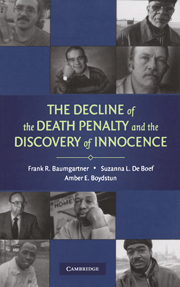Book contents
- Frontmatter
- Contents
- List of Tables
- List of Figures
- Acknowledgments
- 1 Innocence and the Death Penalty Debate
- 2 The Death Penalty in America
- 3 A Chronology of Innocence
- 4 The Shifting Terms of Debate
- 5 Innocence, Resonance, and Old Arguments Made New Again
- 6 Public Opinion
- 7 The Rise and Fall of a Public Policy
- 8 Conclusion
- Epilogue: Individuals Exonerated from Death Row
- Appendix A New York Times capital punishment coverage, 1960 to 2005
- Appendix B Description of Data
- Notes
- References
- Index
5 - Innocence, Resonance, and Old Arguments Made New Again
Published online by Cambridge University Press: 05 September 2012
- Frontmatter
- Contents
- List of Tables
- List of Figures
- Acknowledgments
- 1 Innocence and the Death Penalty Debate
- 2 The Death Penalty in America
- 3 A Chronology of Innocence
- 4 The Shifting Terms of Debate
- 5 Innocence, Resonance, and Old Arguments Made New Again
- 6 Public Opinion
- 7 The Rise and Fall of a Public Policy
- 8 Conclusion
- Epilogue: Individuals Exonerated from Death Row
- Appendix A New York Times capital punishment coverage, 1960 to 2005
- Appendix B Description of Data
- Notes
- References
- Index
Summary
We have argued, in previous chapters, that the innocence frame is one of unparalleled potency. In Figure 4.5, we showed that the fairness dimension, fueled by arguments 316 (evidence), 317 (innocence), and 318 (system is broken), has come to dominate the death penalty debate at unprecedented levels of attention. But just how different is it? In this chapter, we subject the innocence frame to more rigorous scrutiny. We begin by offering a theoretical account of the components of the issue-framing process in general, and we present an accompanying methodology called evolutionary factor analysis (EFA). We use this new method to assess statistically the muscle power of the innocence frame. As suspected, it packs a wallop.
Our theory of framing centers on the premise that defining an issue debate involves more than just the frequency of attention. How often arguments like evidence or innocence are used matters, of course, but also important is the extent to which these arguments are used in conjunction with one another to form a larger cohesive frame, as well as how long the frame persists. Following our theoretical understanding of how framing works, the EFA method allows researchers to trace how frames evolve over time in an issue debate. We apply this method here to our study of capital punishment, and we are rewarded for our efforts in two important ways. First, our results here confirm results presented in previous chapters based on the more basic technique of “frequency analysis” (i.e., counting the number of stories using each argument at each point in time).
- Type
- Chapter
- Information
- The Decline of the Death Penalty and the Discovery of Innocence , pp. 136 - 165Publisher: Cambridge University PressPrint publication year: 2008



